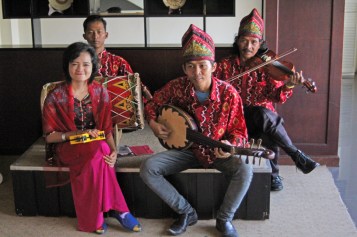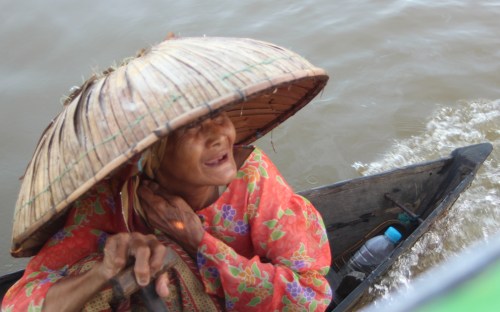Borneo Day 4: Monday, July 24, 2017

The chemistry (kimia) class at SMAN 1 Mandastana near Banjarmasin, South Kalimantan.
Today we got to do what we came all this way for: to teach at a school in Borneo.
All schools in Indonesia start Mondays with an early morning flag ceremony, so we had to leave the hotel early to make it. After breakfast, Nazar picked us up in the lobby at 7:00. We drove across the Sangai Martapura and onto the road leading north out of the city that we had used the day before. We turned onto Jalan Ahmad Yani and headed toward the Barito River Bridge, but before getting that far we turned north onto a narrow country lane. This traveled straight through rice fields and past scattered houses to a wooden bridge across a canal, then turned west. I could see the school to our north, a blue building next to a grass field.
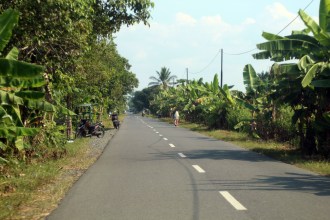
Jalan Achmed Yani, or the Trans Kalimantan Highway. We drove on this out of Banjarmasin to the northwest, then took a smaller country road to the school.
I recognized it from looking up their website and talking about it to my students. This is SMAN 1 Mandastana, the school where Nazar and his wife teach. We passed the school and immediately turned back north onto a somewhat worn cement road leading to the front entrance.

The school is north of Banjarmasin about 15 km and is in the middle of rice fields. This is the view on the way to the school.
Nazar drove up to the entrance and we saw a sign hanging up welcoming Craig and I by name. We walked in through a breezeway into the school’s main office area and put our bags in the headmaster’s office (except my camera bag), then walked out into the main courtyard. The students and teachers were already assembled in ranks, waiting for our arrival. Our big moment had arrived!
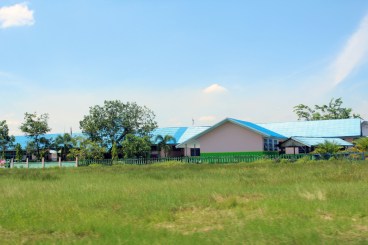
SMA Negeri 1 in Mandastana, near Banjarmasin. This is the school the Craig Hendrick and I taught at for a week in Borneo.
It is hard to express how I felt. I was being given the honors of a master teacher, an education ambassador who had traveled all this way from America to teach at this school. It was difficult for my mind to accept that I deserved this level of respect. Yes, I had come from America to teach here, but although I have multiple award plaques and certificates attesting that I am a master teacher, I have never really believed it in my heart. I know I have so many ways to improve as a teacher, even after 26 years of doing it. I’ve known so many teachers who were more deserving than me, who should be here instead of me.

Our welcome sign at SMAN 1 Mandastana.
I wanted to shout out that they had the wrong guy, that the name on the banner must be some other David Black and not me. Yet here I was – half way around the world, about to attempt to teach in a place I’d never heard of before to a people I knew very little about. How very presumptuous of me. Yet buried under all that uncertainty was a part of me that knew I had finally arrived, that all my hard work at being an education professional and presenting at all those conferences was finally paying off. That I deserved all of this. I wanted to bask in the attention. I wanted to run away. I was thrilled to be there. I was scared to death.

Students at SMAN 1 Mandastana standing at attention during their Monday morning flag ceremony.
I finally decided that even if I didn’t know whether or not I was a master teacher, it didn’t matter. All I had to worry about was that I should be a teacher, nothing more. If the students will let me, I can find the common ground that will allow me to be what I know how to be.
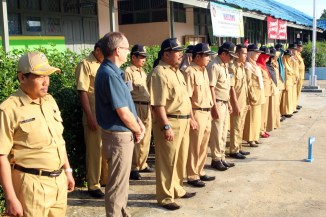
Craig Hendrick standing with the teachers at SMAN 1 Mandastana for the Monday morning flag ceremony.
We were asked to stand with the other teachers, who were wearing khaki uniforms. The students were in white shirts and blouses, white hijabs, and gray pants or dresses. They stood with their backs to the morning sun, but it was directly in our faces and already blazing hot. As the ceremony progressed, I stepped out of line a few times ostensibly to take photos but also to turn away from the sun for a few moments, as it was making my eyes water and I was beginning to sweat.

Raising the Indonesian flag at the Monday morning flag ceremony of SMAN 1 Mandastana.
A squad of students marched in practiced formation to the flagpole and unfurled the red and white Indonesian flag. A group of girls sang the national anthem, and the squad attached the flag and slowly raised it until it reached the top as the anthem ended. A teacher recited the five Pancasila principles from a microphone on a podium while the students repeated. Then we were introduced and each made a few remarks while Nazar translated. The ceremony ended and we took some photos of us with the entire school.
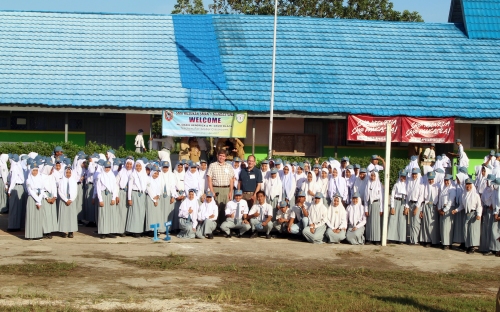
David Black and Craig Hendrick posing with the students of SMAN 1 Mandastana after the Monday morning flag ceremony.
As the students moved to their first period classes, we went into the headmaster’s office for a few minutes. He offered us some snacks and we answered his questions through Nazar. We were then ready to meet the students.

Meeting the Headmaster (Principal) of SMAN 1 Mandastana.
There are two English teachers at this school. I went with Nazar and Craig went with the other teacher, whose English is also fairly good. The school is built in an almost enclosed letter C shape around a central courtyard, with the offices at the bottom of the C, the computer and language lab on the small right leg with the kanteen or cafeteria at the end and a separate wing almost completing the open part of the C. A new classroom was being built at the far end. On the left side, the longest side of the C, is classrooms with a tile walkway in front and a wooden walkway beyond along the inside edge. The front area of the courtyard is cemented and used for the flag ceremonies and for volleyball, basketball, and soccer. There is a small grassy area behind that, along with a greenhouse that is being built for the biology classes. The grass becomes more swampy as it goes further back, along the top curve of the C. The entire school is built up on stilts to prevent it sinking.
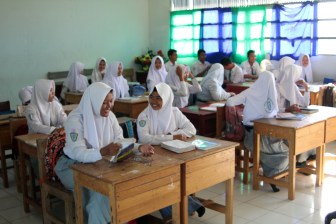
Nazar’s English class at SMAN 1 Mandastana. This is the class that I first presented to, showing a slide show about my home, school, and family.
I walked with Nazar on the left side of the horseshoe. Racks of plants and flowers are growing across the tile walkway, causing us to step down onto the wooden walkway next to the swampy area. I wheeled my blue suitcase around these obstacles as best I could, until we could step up onto the tiles walkway for the top section of the C, where Nazar’s first class is located.
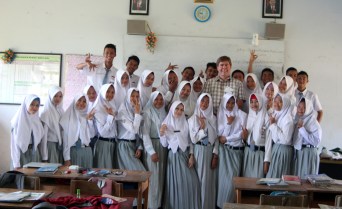
Posing with the English class after our lesson. They like to take photos and selfies. They will pose seriously, then do a “freestyle” pose such as this one.
Since Indonesian students stay put in one classroom (except for PE or for classes that require specialized labs, such as Kimia or Fisika), the teachers are the ones to travel. Nazar’s morning English class was in the north wing. The students were excited to see me as I wheeled my stuff in and set up my computer. Nazar had grabbed a portable projector, as the one mounted on the ceiling in the room didn’t seem to be working. I had remembered to bring the power converter with me, so I was able to plug my computer into an extension power strip. I had remembered to bring a VGA cord and my conversion dongle, knowing that HDMI probably wouldn’t be available (but I had an HDMI cord, too, just in case – this is why my carry ons are so heavy). Fortunately everything worked, and I was able to project onto a light blue wall at the front of the class.

Posing with the girls in one of the chemistry classes at SMAN 1 Mandastana.
I had prepared two slide shows, one the night before about American Academy of Innovation and a second show with harder English about the trip my family made to the Four Corners region of Utah, Colorado, New Mexico, and Arizona at the end of June. This one was more about geography and geology.

Posing with the boys in the chemistry class. They wanted a separate photo from the girls. There were more girls than boys in the class. I don’t know if this is the case for all science classes or not.
I showed the first slide show during the first block of the period (45 minutes). Nazar translated for me. The students watched carefully, and exclaimed when they saw the photo of my school on a snowy day. They have never seen snow in their lives. After, I asked if they had questions but they were reluctant to speak, probably because they were afraid their English wasn’t good enough. A couple of students were able to ask a few questions.
When the bell rang, it sounded exactly like the tones played in the Hunger Games movies to announce that a contestant had died. Craig and I both found this a bit unnerving.
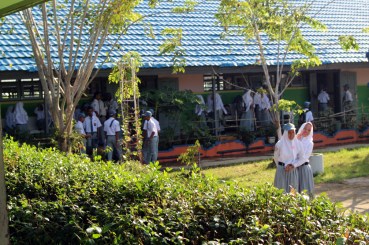
The inner courtyard of SMAN 1 Mandastana. Since there isn’t snow or cold weather, there are not internal hallways, similar to schools in California. The students wear gray pants/skirts and white shirts/blouses with hajibs and/or hats on Mondays.
During the second block of the 90-minute class, I showed my higher-level slide show on the geography and geology of the western U.S. They were interested in the comparison slide I had made between Borneo and Utah and the other four corner states, that Borneo is 3.38 times larger than Utah and just barely smaller than all four states. But as I showed the various national parks (Taman Nasional) and our route, I could tell that the English was too hard for them. They had fewer questions than I had hoped. I picked things up by opening up my blue case and handing out flyers, brochures, and other materials I had been given at the Utah Valley Visitors Bureau the day before I left Utah. They were excited to get them and have something to practice on.

A birthday cake for a student in the Language Lab room.
At the end of the class, all the students came up and insisted on taking group and individual photos, including many selfies. They wanted photos in normal pose and what they call “freestyle” which is to pose in a less formal fashion. As I was leaving the classroom, all the students came up and did something they had told us about, but which still came as a surprise. Each student took my hand and placed it against their forehead or cheek or kissed it. This is a normal sign of respect for teachers in Indonesia.
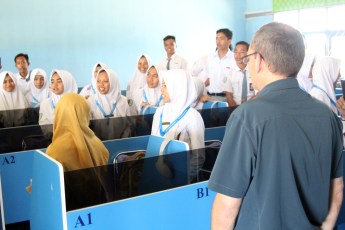
Craig Hendrick teaching in the Language Lab room to students at SMAN 1 Mandastana in Borneo.
The bell rang again (another dead contestant!) and Craig and I traded classrooms. The other English teacher was teaching in the chemistry classroom and we waited a few minutes while the chemistry teacher finished up her lesson. This was the second week of school, and she was reviewing mole fractions (mol fraksi), a subject I don’t often teach until deep into second semester. Even though she was speaking and writing in Indonesian, I was able to follow most of what she was doing as the language of science is fairly universal. Indonesians use Arabic numerals just as we do, and with many words transliterated from Latin in a phonetic alphabet, I was able to follow much of what was written. The teacher was lecturing and writing on the board while students took notes. I walked around and noticed that the students’ handwriting was extremely neat, better than any writing I’ve seen in America (including my own).

Student notes on mole fractions (mol fractsi). Notice the neat handwriting.
Once the lesson was over, I set up the projector again and went through my slide shows. When I came to showing some of the activities my students have done, I had a slide showing two students doing a version of the flame test lab as a demonstration, a lab I’ve done many times. One of the students asked if they could do the lab (through the English teacher) and I looked at the chemistry teacher, who was still in the room, and said we’d have to see what materials she had.

The library at SMAN 1 Mandastana.
After the second slide show was done, I handed out more tourism brochures to these students. We took group photos and selfies again, and as they were leaving to go to mosque, they bowed their heads and kissed my hand as had the other class. This gets to the heart of my basic doubts about myself – that I don’t deserve the great respect they are showing me. Certainly I’ve never seen anything like it before. I wanted to bow back to them, but was told by Nazar later that I don’t have to do that.

Indonesian periodic table. Most of the element names are based on the Latin root words, such as Kalium for potassium (K). Some of the elements, such as Tembago for Copper, must be Indonesian words that predate the introduction of western science.
After the class was over and the students left, we looked through the chemistry supplies and discovered enough materials to make the flame test work. We’ll try the lab tomorrow. While looking through the classroom, I took photos of the periodic table hanging up at the back of the room. I could recognize most of the elemental names, based on the original Latin names, such as kalium for potassium and natrium for sodium. Only a few elements, such as tembago (copper) or beso (iron), were unfamiliar. These must be names that predate chemistry as a science in Indonesia.

Student crafts, including a traditional Bajarese house, on display in the library.
As I walked back to the teachers lounge, I thought of how things had gone and my impressions of it. All of my teaching career I’ve wanted to make a difference in the world, which I have done. There is a part of me that would like to be well known if not famous, perhaps even remembered by history. Whether or not this ever happens, I can at least say that for this week, I was shown the greatest respect I’ve ever known as a teacher.

Teachers’ Preparation Room at SMAN 1 Mandastana. Overall, this school had a lot more light and seemed more airy than schools in Jakarta. There was no air conditioning, so ceiling fans and open windows were the only ventilation. Teachers wear khaki uniforms on Mondays.
Read Full Post »

















































































